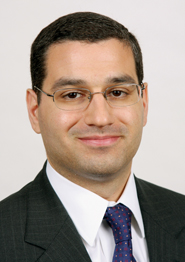The volatility seen in stock markets this year has been high. And it will continue. But it may not be that unprecedented, according to Joseph Mecane, chief administrative officer for US. markets of NYSE Euronext.

Take August, he told professionals gathered at the Marriott Marquis hotel in New York for the annual meeting of the Securities Industry and Financial Markets Association.
That was the month that was led off by Standard & Poor’s downgrading U.S. debt for the first time. That triggered four straight days of the Dow Jones Industrial Average moving up or down by 400 points or move, a first.
All told, Mecane said, the value of equities markets moved up or down more than 1 percent 11 or 12 times in August, he said.
"People feel they’re getting whipsawed,” Mecane said. But NYSE Euronext conducted a study of markets for the past 75 years and found the volatility is not that unusual.
Without citing statistics, Mecane said, "the perception of volatility — and perception is what matters — is high. But it’s not necessarily unprecedented."
Volatility is not a result of improper functioning of marketplaces, even with the high level of automation that is involved now, said Eric Noll, Eric Noll, executive vice president, transaction services in the U.S., for the Nasdaq OMX Group.

Rather, it is "a reflection of the larger macroeconomic environment,” said Noll.
The "incredible economic crisis" that began in late 2008 and continues to the present is what generates the volatility, he said. This gets "expressed in equities prices" and is a reflection of "underlying instability of the global economy," he said.
Other types of financial assets other than stocks, such as foreign currency and bonds, have had "bigger dislocations,” he said.
Volatiltiy and speed is "breathtaking,” according to William J. Brodsky, chairman and chief executive officer, Chicago Board Options Exchange, which created a Volatilty Index on which options and other contracts are traded.
That puts the onus on market operators to educate investors on how markets work and there is a "higher bar than ever before" that volatility and high-speed trading are not "boogey men." "Financial markets by their nature are volatile,” he said.
Single-stock circuit breakers and limits on how much a stock can move up or down in a given trading session should take out panic, said Noll and Paul Russo, head of U.S. equities trading and head of global equities, One Delta Trading, Goldman Sachs & Co.
"I think people are confused,” Russo said. "The level of uncertainty that exists for a bunch of wholly good explainable reasons is real." Trying to believe we "can stop that in the markets is not a reality,” he said. The bigger question is what beyond circuit breakers may bear a closer look. Russo suggested market data, which is, his view, the gasoline that fuels high-speed markets today.
Electronic markets increasingly rely on hundreds of millions of market data messages being funneled across networks effectively and accurately every minute. And, Russo suggested, markets tend to break down — like in the May 6, 2010 Flash Crash — when anomalies appear in the data that markets rely on.
The Flash Crash, said Brodsky, was not a result of volatility — even though prices fell hundreds of points in a matter of minutes. And then bounced back. That was a "micro market structure phenomenon,” he said. And he’s comfortable that won’t happen again, with the single-stock circuit breakers in place and stub quotes removed.
But changes that are aimed at fundamental functions, like the exchange of market data, will require close and careful scrutiny, Russo said.
"We think we’re getting to a safer world,” Russo said. But the speed of trading, where a stock can drop from $46 to a penny in four thousandths of a second, "makes this a very highly tuned engine and you have to be careful how you tinker with it."
This story originally appeared in Securities Technology Monitor.




